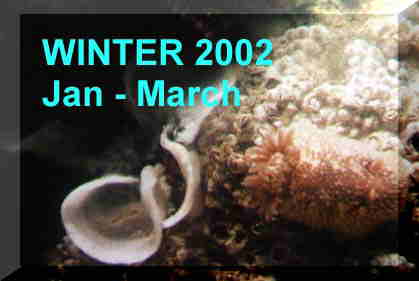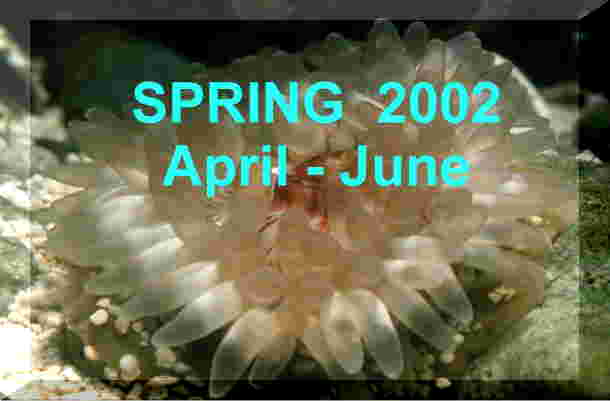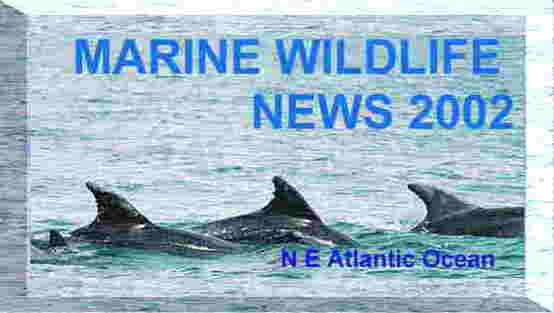
|
|
|
|
|
(BMLSS *** Site) |
|
|
|
Norwegian Marine*** |
|
L-I-N-K-S to Other Sites (Click on Text) |
|
Smart Group |
|
How to Join |
|
|
|
|
|
Recommended Sites |
|
|
|
|
|
|

Monthly Marine News Bulletin |
|
Marine Nature Conservation Review Survey Database |
|
|
 |
|
|
|
|
|
|
.
MARINE LIFE NEWS
Reports of marine wildlife from all around the British Isles, with pollution incidents and conservation initiatives as they affect the fauna and flora of the NE Atlantic Ocean.
on Microsoft Internet Explorer (best) or Netscape
 |
 |
 |
 |
- LATEST
NEWS
27 December 2002
A Minke Whale, Balaenoptera acutorostrata, is spotted just before midday stranded on some rocks in Portland Harbour, Dorset. The coastguards were called and they managed to push the whale back into the water and it spent the rest of the day swimming around the large natural harbour, but it has yet to be coaxed back out to the open sea. This species of whale is rarely seen in the shallower parts of the English Channel.
BBC News Report
Corrected Report by Clive Martin (Biscay Dolphin Research Programme)
BMLSS Cetacea
Minke Whale stranded on the Isle of Wight in early 200326 December 2002
A group of ten (including one calf) Bottle-nosed Dolphins, Tursiops truncatus, are spotted feeding at the entrance of Aberdeen harbour, north-east Scotland.Report by Kevin Hepworth via Grampian Wildlife News
22 December 2002
Oiled seabirds, mainly Guillemots, are being washed up in greater numbers than normal on the Kent coast. The RSPCA rehabilitation centre at Mallydams Wood near Hastings, East Sussex, has already dealt with over 400 birds, four times the usual number (which was 92 in 2001).
Report Number Tel: 08705 555 999 (RSPCA)Report by the Sandwich Bay Bird Observatory via KosnetFull Report
BMLSS Oiled Birds Page17 December 2002
Phocine Distemper Virus (PDV)
Between 11 December and 17 December there have been 47 dead seals reported around the UK bringing the total to 3682 since the beginning of the outbreak. The English deaths were down to 16 in the last week and are falling in Scottish seas after a sharp rise to 133 dead carcasses in the week ending 4 December 2002.
It is the total number of dead seals reported, irrespective of what they died of and this recent rise of mortality in Scottish seals has probably got more to do with the Grey Seal pupping period than any extra spread of the virus.
Weekly Graph (epidemic started 14 August 2002)
PDV Update
Status Report 19
BMLSS Seals12 December 2002
Video Footage
Early in the morning a young eight metre long Humpback Whale, Megaptera novaengliae, entered the naval harbour of Frederikshavn on the northern Kattegat coast of Denmark. It remained in the harbour for the whole of the day and is believed to be feeding on the shoals of small fish seen. These whales are rarely seen around the mainland British Isles.
Cornish Humpback
BMLSS Cetacea News11 December 2002
Taking up this theme of the wildlife that surrounds us, but which is terra incognito to most of us amateur naturalists, Barry Collins (wildlife warden for Thorney Island) contributes an apt example from his observation of a marker post recently washed up on the Pilsey Sands in Chichester Harbour, Sussex. The section of the post which had for years been under water was covered with a thousand Goose Barnacles, Lepas anatifera, looking like silvery grey mussel shells around 5 cm (2 inches) long, each attached to the post by a long flexible brown stem which may be 20 cm (8 inches) long allowing the living crustacean to reach out into the surrounding water to feed.Report on Ralph Hollin's Nature NotesNB: On previous occasions, local buoys thought to have provided habitats for Lepas have discovered top be buoys from much further afield, e.g. meteorological buoys from the Atlantic Ocean.
BMLSS Barnacles5 December 2002
In the last few weeks 640 oiled sea birds have been washed up on the East Anglian coasts of Suffolk and Norfolk. The source of the oil has not been discovered, but it is believed to have been released from an old wreck.
BBC Television News Report
The Maritime & Coastguard Agency have made sent up spotter planes and received reports of slicks of oil on 19 and 21 November 2002, relatively small ones compared to a major disaster.Report from Tony Child (Thanet Coast Project Officer)BMLSS Oil Spills Page28 November 2002
Eight Sperm Whales, Physeter macrocephalus, were spotted swimming in the waters between East Holm and Burray in the Okney Isles, north Scotland. SSPCA Inspector Mike Lynch said that the whales were clearly visible from the Hurtiso area and he hoped that they would swim out to sea on their own accord.Report by Nic Crocker, Bewan, Papa Westray OrkneyLate November 2002
on Sea Watch Foundation News
A Short-snouted Seahorse, Hippocampus hippocampus, is captured by an oyster fisherman in the Solent. In Victorian times, there are records from off Dorset and the Solent.Report by Ivor ReesEarlier 2002 Report from off Dorset
A dead Boar Fish, Capros aper, was brought into the National Marine Aquarium, Plymouth for identification. The fishermen call them "Zulus" and used to catch them regularly, but they are now almost unknown in the local catches, but I am told that lots are caught by the beam trawlers fishing for Sole in deep water on the Parson's and Great Sole Banks about 120 miles SW of the Lizard, Cornwall.
18
November 2002
Common Octopus
Photograph © by Richard
Lord (Guernsey)
Another large Common Octopus, Octopus vulgaris, is captured alive off the Channel Islands and brought into Guernsey alive but failed to survive. This is the third one recorded since the beginning of October 2002.
Three Common Octopuses were also reported from Cornwall during the first weeks of November 2002.
 15
November 2002
15
November 2002
After
the recent gales, further large numbers of freshly dead Velella
are washed up on the Dorset (Studland) coast with over 50 counted in a
stretch of strandline of 100 metres. The dead Velella were still
coloured blue which showed that that they have only recently died. They
disintegrate and turn white over night. There were live specimens at five
miles off the Dorset coast.
13
November 2002
An
exceptionally large Electric Ray,
Torpedo
nobiliana, 25 kg and almost a metre across was brought in alive at
Plymouth and it found a home at the Blue Reef
Aquarium, Newquay. This ray is rarely seen in Public Aquaria, because
of their danger and the difficulty in keeping them. Unfortunately, this
specimen was damaged on capture and did not survive its ordeal.
13
November 2002
The oil tanker Prestige,
carrying more than 70,000 tons of oil, suffered severe wave damage off
the north coast of Spain, and began spilling heavy fuel oil into the sea.
It was towed out to deeper water by the Spanish authorities where on 19
November 2002 sunk to the bottom of the sea carrying its cargo of
oil with it to a depth of 3400 metres. The oil slicks were washed ashore
in the intervening period and on into December.
By
5 December 2002 the amount of oil released
into the surface areas of the sea and pushed inshore my the prevailing
winds is estimated at 20,000 tonnes. The first slick that hit the shore
was 6,000 tonnes and the second larger slick of 11,0000 tonnes arrived
on the coast of Galicia (around Finisterre) in north-west Spain at the
beginning
of December.
The fishing
ban has been extended from Cedeira (northern Galicia) to Guardia (Miño
river mouth). It is the outer estuaries that have suffered the most, but
the rias of Arousa, Pontevedra and Vigo have been protected by efforts
of the local fishermen. The nature reserve of Cies Islands, the most important
in Galicia are highly polluted with the oil.
Report
from Spain
Reports
(Marine Wildlife of the North-east Atlantic Ocean Group)
BBC
News Story
BMLSS
Oil Spills Page
5 November
2002
Collecting
a few rocks for aquarium props in fading light
on Lancing Beach, West Sussex, on a moonless
evening under torchlight, I made my first discovery of the Arch-fronted
Swimming Crab, Liocarcinus
arcuatus, at low tide. This is the
first BMLSS Report from the shore. The
identity of this crab has been confirmed by Dr.
Reindert Nijland.
This
small specimen of this crab (carapace width 25 mm) had a heavy carpus on
both chelae, a rough carapace in chocolate brown, swimming legs
that were pointed, slower moving than Necora,
with also are pronounced creamy white underside, and at dusk that was only
its fractionally different movement that made it stand out from the Shore
Crab. There were no "teeth" between the eyes, and the carapace was
in a straight line between the eyes, with red antennae and antennules.
Full
Report
BMLSS
Intertidal Crabs
2
November 2002
The
capture on rod and line by Peter
Weight of a Boar
Fish, Capros aper,
from Hove beach is the very first record of this fish caught from the shore
off Sussex. The books
say that this fish lives in depths of over 100 metres and as there are
no seas of this depth on the English
side of the English Channel. This pretty little red
and silver rhomboidal fish about 55 mm long,
excluding its caudal fin, large eye and large mouth, with a spiky first
dorsal and vibrating second dorsal and second anal fins (vibrating like
the dorsal fin of a pipefish). Although this
fish is rarely caught, it is abundant in deepish water (on the edge of
the continental shelf in the western approaches of the English Channel)
and it is just that normal fishing methods do not capture this small fish.
All records and especially all live records from the shore or on dives,
and all Sussex records are newsworthy.
This
fish is thriving in the BMLSS private aquarium (Shoreham-by-Sea).
This fish is rarely on display in British Public Aquaria
and the only known display of this fish was for several years at Mevagissey
Harbour Aquarium.
This
specimen appeared live on Meridian TV Southern News on 6
November 2002.
On
10 November 2002, after a week in captivity,
the Boar Fish
commenced to feed on frozen brine shrimp after being initially encouraged
with live daphnia.
Previous
Sussex Record of a Boar Fish
Previous
Report from the Channel Islands
BMLSS
Boar Fish
Late
October 2002
A
Cornish fisherman reported netting a shoal of 10 stone (140 lb = 64
kg) of these small Boar Fish
just 10 miles off the Isles of Scilly whilst fishing for squid.
30
October 2002
A
Mantis
Shrimp, Rissoides desmaresti, was captured off Selsey Bill
(Pullar Bank), West Sussex. The skipper of a registered fishing vessel
operating from Selsey caught the shrimp in his lobster pots. This was only
the second he had ever caught in over 20 years commercial fishing from
Selsey. Robert Clark, Senior Fishery Officer
with the Sussex Sea Fisheries Committee, identified
the shrimp to species level.
News 1999 Page (Mantis Shrimp Report)
26
October 2002
The
Marine
Conservation Society Annual Conference was held at the Royal Museum,
Edinburgh.
Diary:
Further Details
25
October 2002
Fishing
Monthly
Scientists
confirmed today that cod stocks in the North Sea, Irish Sea and waters
West of Scotland are at their lowest recorded level and are in danger of
collapse unless urgent action is taken.
The
International
Council for the Exploration of the Sea,
wants closure of all cod fishing whether directed or by-catch in these
areas.
The
North Sea cod restriction would also apply to the Eastern Channel and Skagerrak
and is necessary in all the named areas because of very low stock size
due to poor stock recruitment and high fishing mortality
The
scientists do not set a time limit on the draconian restrictions but say
they should stay until there is "clear evidence" of the recovery of the
stock to a size associated with a reasonable probability of good recruitment.
[extracts]
Full
Report
23
October 2002
An
organised whale watching boat trip off West Cork, Ireland, discovered the
usual cloud of Gannets
diving into the sea with three species of dolphins all feeding on the large
fish shoals. 30+ Atlantic White-sided Dolphins
Lagenorhynchus
acutus, 20+ Common Dolphins Delphinus
delphis, and a small group of four or five Striped
Dolphins, Stenella
coeruleoalba.
24
October 2002
Between
16 October and 22 October there have been
195 dead seals reported around the UK bringing the total to 2845 since
the beginning of the Phocine Distemper
Virus outbreak. 2451 of the seals have
been found on the English coasts, with all but 24 of the above total discovered
dead on the east coast. Confirmed cases are mostly Common
Seals, Phoca vitulina, but also
a few Grey Seals, Halichoerus grypus.
Sea
Mammal Research Unit
Status
Report 11 (with further details)
BMLSS
Seals
11
October 2002
A
very large gastropod called the Triton
Whelk (now
usually called the Triton Shell),
Charonia
lampas (L.), was discovered in the mouth of the River Fowey, Cornwall,
and put on display at Mevagissey
Harbour Aquarium. This is a very rare
find, and this large gastropod has only been recorded in British seas on
a few occasions. It is a southerly species known from the Mediterranean
Sea. It may have received assisted passage on the bottom of a boat?
October
2002
Anglers
Gareth
Larry and Ryan Dalziel caught
20 Redfish
(=Ocean Perch), Sebastes marinus, 40
miles north west of Muckle Flagg, Unst, northernmost island of the Shetland
Isles, at a depth of 166 metres (91 fathoms) with Coalfish (=Saithe), Pollachius
virens. The largest Redfish
weighed 1.58 kg (3½ lb) and this will probably qualify as
a new species rod and line record for Britain. The Redfish is a common
fish of the Lophelia (deep water coral) beds like the Sula
Ridge. However, it is a deep water species and in shallow water a similar
species Sebastes viviparus, sometimes called the Norway
Haddock is sometimes caught.
7
October 2002
A
Bluefin
Tuna, Thunnus thynnus with a reported weight of 321 kg (708
lb)
was
caught off the north-west coast of Ireland by angler
Martin
O'Malley. Bluefin Tuna were also caught of
the Galway coast and in Donegal Bay earlier in the year. At least 24 tuna
were hooked off the Irish coast in 2002.
6 October
2002
 With
Indian
Summer summer preceding some of the highest and lowest equinoctial
spring tides for over 20 years was too good a rockpooling
chance to miss as low tide receded to Chart
Datum about 6:00 pm,
just before an attractive red sunset.
With
Indian
Summer summer preceding some of the highest and lowest equinoctial
spring tides for over 20 years was too good a rockpooling
chance to miss as low tide receded to Chart
Datum about 6:00 pm,
just before an attractive red sunset.
The
low tide on Lancing beach, West Sussex,
revealed shallow pools and rocks covered in weed, and my very first discovery
of the South-claw Hermit Crab,
Diogenes
pugilator, on the Sussex coast.
Full
Report
4
October 2002
A
Guernsey fisherman caught a large Common
Octopus, Octopus vulgaris, in a
crab pot about half a mile from Hanois Lighthouse off the south-western
tip of Guernsey. The octopus had devoured at least two Edible
Crabs and one Lobster. The fisherman estimated
the total length at about 1.5 metres and the tentacle length at 1 metre.
He estimated the weight at 4.5 to 5.5 kg (10 to 12 lb). He
returned the octopus to the sea.
Another
Guernsey fisherman caught a large Octopus vulgaris in July
2002.
3 October
2002
The
Geoneedle
at Orcombe Point,
Exmouth, was
unveiled by Charles,
Prince of Wales, to mark the western end of the Jurrassic Coast, a
World Heritage Site. It is made from a sample of each of the different
rock types along the Jurassic Coast.
Image
c.
1 October 2002
Chris
Bean caught a Marbled
Electric Ray, Torpedo marmorata,
somewhere off Helford River, Cornwall. This southern species is the rarer
on the two species of electric ray in British seas.
FOR 2001 REPORTS CLICK ON THE BUTTON BELOW

The Marine Wildlife of the NE Atlantic Forum.
PLEASE JOIN

MARINE WILDLIFE of the NE ATLANTIC EFORUM PAGE (LINK TO)
Shetland Wildlife
News & Information on the Wildlife of Shetland http://www.wildlife.shetland.co.uk/Cornish Wildlife
Vince Smith's Cornish Mailing List
Send a message to the list at: CornishWildlife@onelist.com
News 2000
News 1999
|
Use these links if your are familiar with the scientific classifications of marine life |
The BMLSS (England) site commenced on 1 January 1997.
|
|
 |
 |
Andy Horton, Webmaster
|
|
|
|
|
|
Membership Form |
News 2000 |


